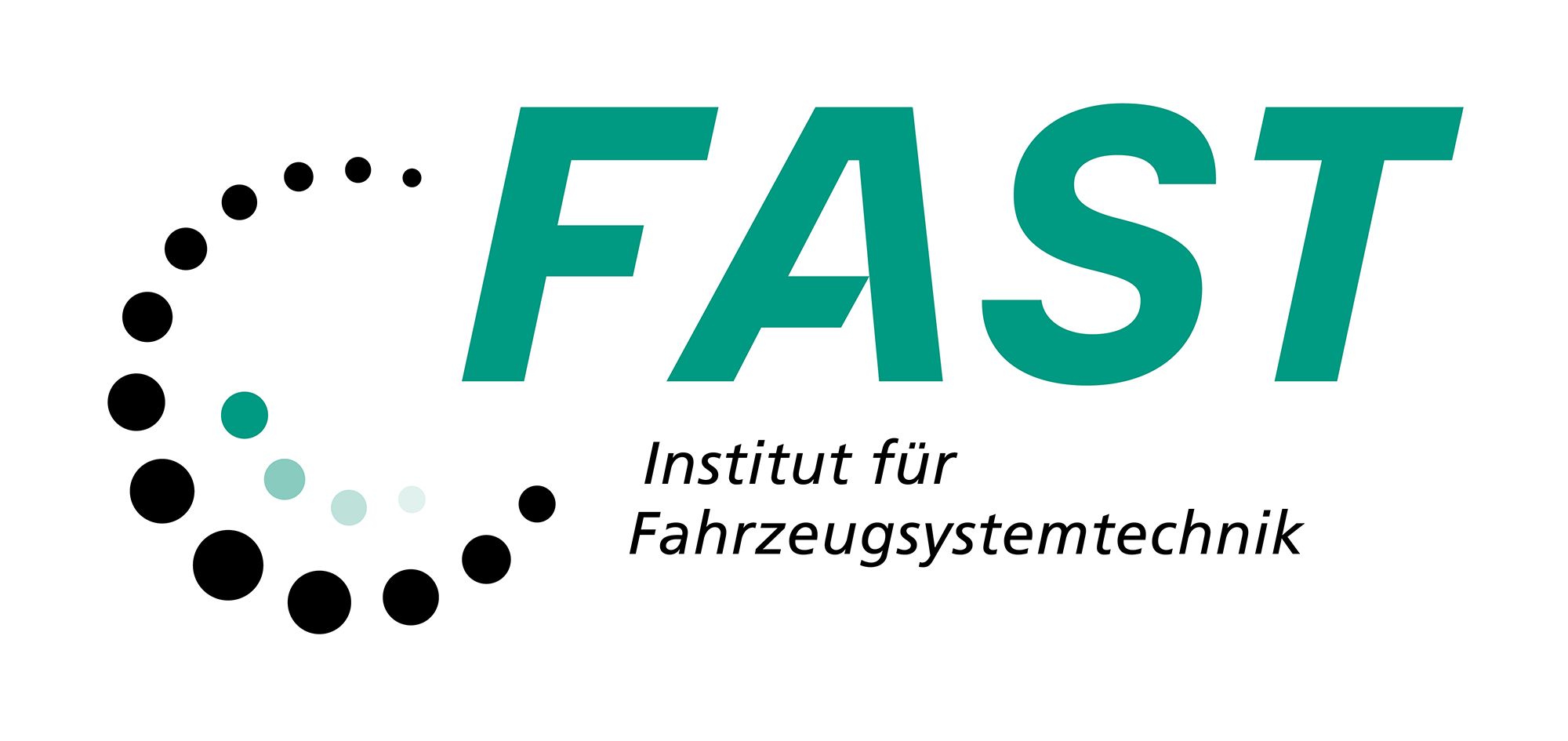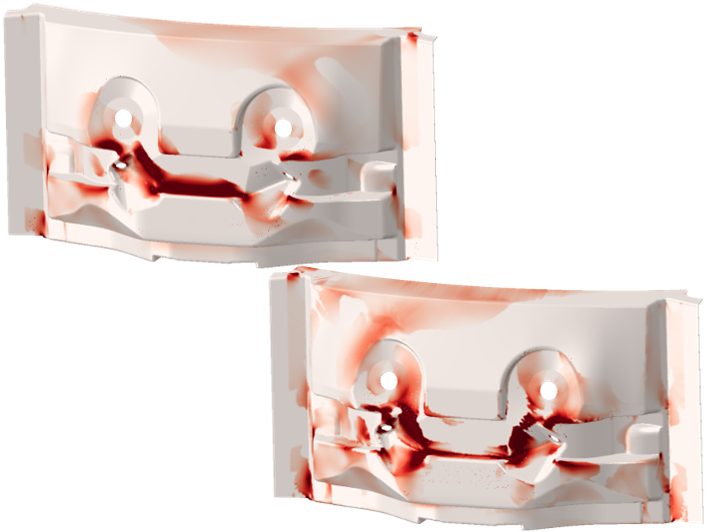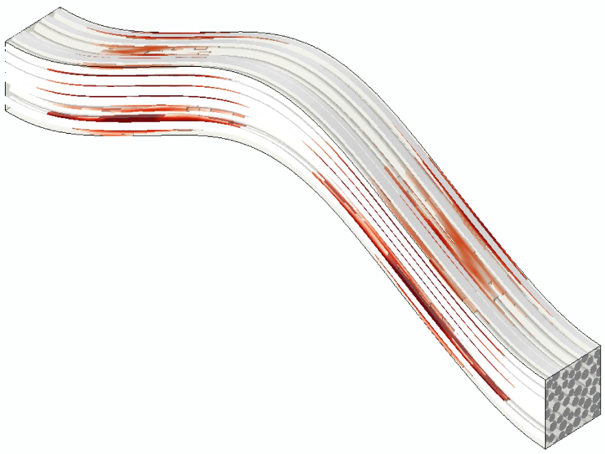Struktursimulation Endlosfaserverbunde
Das Verformungs- und Schädigungsverhalten von Endlosfaserverbundbauteilen wird maßgeblich von der verstärkenden Faserstruktur bestimmt. Faserorientierungen, Faservolumengehalte und lokale Effekte wie Welligkeiten und Klaffungen können infolge des Umformprozesses stark variieren. Um dies bei der Vorhersage des strukturmechanischen Verhaltens zu berücksichtigen, verarbeiten wir die durch die CAE-Kette vorliegenden Prozessinformationen in der Struktursimulation. Hierfür entwickeln wir Materialmodelle, die das nichtlineare Deformationsverhalten und die Schädigungsevolution versagensmodenspezifisch (Faserbruch, Matrixbruch, Delaminationen) in Abhängigkeit der lokalen Faserstruktur erfassen.
Forschungsschwerpunkte
- Virtuelle Bauteilvalidierung
- Berücksichtigung von Fertigungseffekten
- Nichtlineare Materialmodellierung
- Versagensanalyse, Schädigungsevolution
- Dynamische Analyse: Schwingung, Dämpfung, Impact
- Multiskalensimulation
Forschungsprojekte |
Ansprechpartner
|
Ausgewählte Veröffentlichungen im Forschungsfeld
Schelleis, C.; Scheuring, B. M.; Schreyer, L.; Liebig, W. V.; Hrymak, A.; Kärger, L.; Weidenmann, K. A.; Henning, F.
2025. Journal of Thermoplastic Composite Materials, 38 (8), 2922–2944. doi:10.1177/08927057251344252
Refat, M.; Maertens, R.; Weiss, P.; Henning, F.; Schulze, V.; Liebig, W. V.
2025. Polymers, 17 (5), Art.-Nr.: 651. doi:10.3390/polym17050651
Esse, D.; Scheuring, B.; Henning, F.; Liebig, W. V.
2025. Polymer Testing, 146, 108747. doi:10.1016/j.polymertesting.2025.108747
Li, Z.; Jackstadt, A.; Zhang, J.; Liebig, W. V.; Kärger, L.
2025. Polymer Composites, 46 (1), 817–831. doi:10.1002/pc.29028
Jackstadt, A.
2025. doi:10.5445/KSP/1000172235
Jackstadt, A.
2024, Mai 23. Karlsruher Institut für Technologie (KIT). doi:10.5445/IR/1000170788
Jackstadt, A.; Liebig, W. V.; Weidenmann, K. A.; Kärger, L.
2024. Materials & Design, 241, Article no: 112882. doi:10.1016/j.matdes.2024.112882
Galkin, S.
2022, April 14. Karlsruher Institut für Technologie (KIT). doi:10.5445/IR/1000144697
Meyer, N.; Wagemann, E. L.; Jackstadt, A.; Seifried, R.
2022. Computational Particle Mechanics, 9 (6), 1293–1308. doi:10.1007/s40571-022-00471-z
Li, Z.; Zhang, J.; Jackstadt, A.; Kärger, L.
2022. Composite structures, 287, Art.Nr.: 115340. doi:10.1016/j.compstruct.2022.115340
Jackstadt, A.; Liebig, W. V.; Kärger, L.
2022. International journal of mechanical sciences, 216 (216), Art.Nr.: 106964. doi:10.1016/j.ijmecsci.2021.106964
Jackstadt, A.; Frölich, F.; Weidenmann, K.; Kärger, L.
2021. Proceedings in applied mathematics and mechanics, 21 (1), e202100098. doi:10.1002/pamm.202100098
Jackstadt, A.; Kärger, L.
2021. Proceedings in applied mathematics and mechanics, 20 (1), Art.-Nr.: e202000234. doi:10.1002/pamm.202000234
Kärger, L.; Galkin, S.; Dörr, D.; Poppe, C.
2020. Procedia manufacturing, 47, 140–147. doi:10.1016/j.promfg.2020.04.155
Jackstadt, A.; Liebig, W. V.; Sessner, V.; Weidenmann, K. A.; Kärger, L.
2019. Proceedings in applied mathematics and mechanics, 19 (1), e201900048. doi:10.1002/pamm.201900048
Galkin, S.; Kunze, E.; Kärger, L.; Böhm, R.; Gude, M.
2019. Journal of composites science, 3 (1), Article: 19. doi:10.3390/jcs3010019
Liebig, W. V.; Jackstadt, A.; Sessner, V.; Weidenmann, K. A.; Kärger, L.
2019. Composites science and technology, 180, 101–110. doi:10.1016/j.compscitech.2019.04.019
Liebig, W. V.; Sessner, V.; Weidenmann, K. A.; Kärger, L.
2018. Composite Structures, 202, 1109–1113. doi:10.1016/j.compstruct.2018.05.051
Galkin, S.; Schirmaier, F. J.; Kärger, L.
2018. Journal of composite materials, 52 (4), 475–485. doi:10.1177/0021998317709332
Kärger, L.; Bernath, A.; Fritz, F.; Galkin, S.; Magagnato, D.; Oeckerath, A.; Schön, A.; Henning, F.
2015. Composite structures, 132, 350–358. doi:10.1016/j.compstruct.2015.05.047



